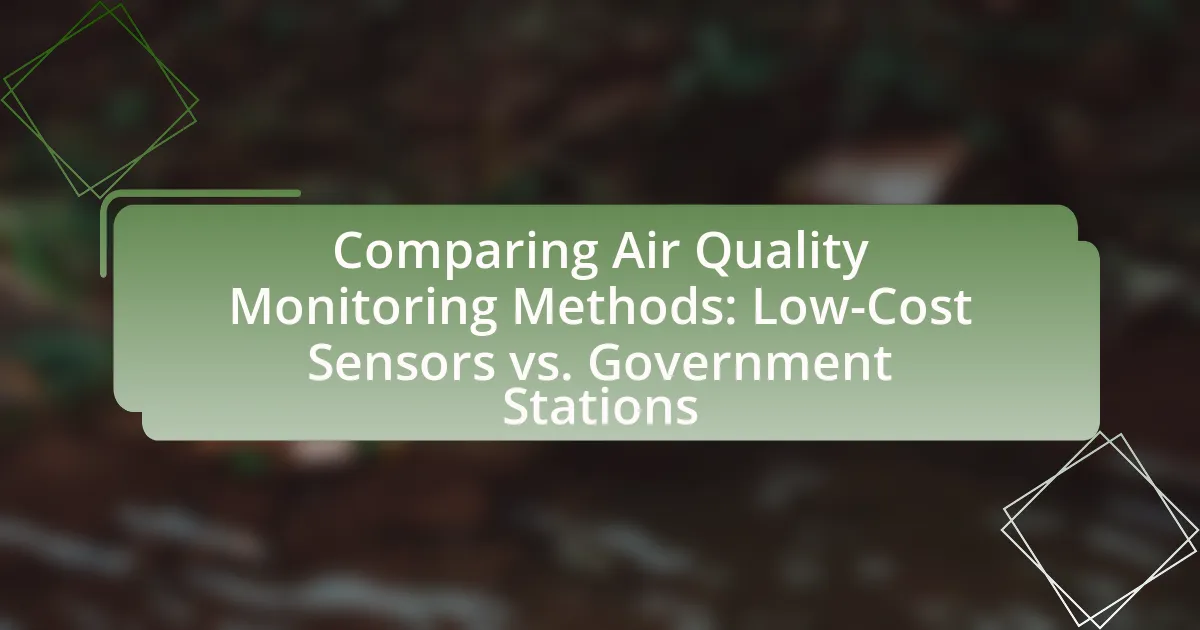The article focuses on comparing air quality monitoring methods, specifically low-cost sensors and government monitoring stations. It outlines the various techniques used for air quality assessment, highlighting the advantages and limitations of each method. Key features of low-cost sensors, such as affordability and real-time data collection, are contrasted with the high accuracy and regulatory compliance of government stations. The article also discusses the importance of air quality monitoring for public health and environmental protection, as well as the role of citizen scientists in enhancing community engagement through localized data collection. Additionally, it provides guidance on selecting the appropriate monitoring method based on specific needs and resources.
What are the different air quality monitoring methods?

The different air quality monitoring methods include low-cost sensors, government monitoring stations, satellite observations, and mobile monitoring units. Low-cost sensors are increasingly popular due to their affordability and ability to provide real-time data, making them accessible for community use. Government monitoring stations, operated by environmental agencies, offer high-accuracy data and are strategically placed to assess air quality across larger regions. Satellite observations provide a broader perspective on air quality trends and pollution sources, while mobile monitoring units can gather data in various locations, offering flexibility in monitoring efforts. Each method has its strengths and limitations, contributing to a comprehensive understanding of air quality.
How do low-cost sensors compare to government stations?
Low-cost sensors generally provide less accurate and reliable data compared to government stations, which are equipped with high-quality instruments and adhere to strict calibration standards. Government stations typically utilize reference-grade equipment that meets regulatory requirements, ensuring precise measurements of air quality parameters. In contrast, low-cost sensors may suffer from issues such as drift, variability, and limited calibration, leading to potential inaccuracies in their readings. Studies have shown that while low-cost sensors can capture trends and provide valuable data for community monitoring, they often lack the robustness and validation found in government-operated monitoring systems. For instance, a study published in Environmental Science & Technology (2018) by the authors of “Evaluating the Performance of Low-Cost Air Quality Sensors” demonstrated that low-cost sensors had significant discrepancies when compared to regulatory monitors, particularly in measuring particulate matter concentrations.
What are the key features of low-cost sensors?
Low-cost sensors are characterized by affordability, compact size, ease of deployment, and the ability to provide real-time data. These sensors typically utilize simple technology, making them accessible for widespread use in various environments. Their affordability allows for extensive deployment in community monitoring projects, enabling data collection from multiple locations simultaneously. Additionally, low-cost sensors often feature user-friendly interfaces, facilitating ease of use for non-experts. Studies have shown that while they may have lower accuracy compared to government-grade sensors, they can still provide valuable insights into air quality trends when calibrated properly.
What are the key features of government monitoring stations?
Government monitoring stations are characterized by their comprehensive data collection capabilities, regulatory compliance, and high-quality standards. These stations are equipped with advanced instrumentation to measure various air pollutants, including particulate matter, nitrogen dioxide, sulfur dioxide, and ozone, ensuring accurate and reliable data. They operate under strict guidelines set by environmental agencies, such as the Environmental Protection Agency (EPA) in the United States, which mandates regular calibration and maintenance of equipment to uphold data integrity. Additionally, government monitoring stations often provide real-time data and long-term trend analysis, contributing to public health assessments and policy-making.
Why is air quality monitoring important?
Air quality monitoring is important because it directly impacts public health, environmental protection, and regulatory compliance. Poor air quality is linked to respiratory diseases, cardiovascular issues, and premature deaths; for instance, the World Health Organization estimates that air pollution causes approximately 7 million deaths annually. Monitoring air quality helps identify pollution sources, assess compliance with air quality standards, and inform policy decisions aimed at improving air quality and protecting community health.
What health impacts are associated with poor air quality?
Poor air quality is associated with a range of significant health impacts, including respiratory diseases, cardiovascular problems, and adverse effects on mental health. Studies have shown that exposure to pollutants such as particulate matter (PM2.5), nitrogen dioxide (NO2), and sulfur dioxide (SO2) can lead to increased hospital admissions for asthma and chronic obstructive pulmonary disease (COPD). For instance, the World Health Organization reports that air pollution is responsible for approximately 7 million premature deaths annually, primarily due to heart disease and stroke linked to poor air quality. Additionally, long-term exposure to polluted air has been correlated with cognitive decline and increased risk of neurological disorders, highlighting the extensive health risks posed by inadequate air quality.
How does air quality affect the environment?
Air quality significantly affects the environment by influencing ecosystems, climate, and human health. Poor air quality, characterized by high levels of pollutants such as particulate matter and nitrogen oxides, can lead to acid rain, which damages soil, water bodies, and vegetation. For instance, the World Health Organization reports that air pollution contributes to approximately 4.2 million premature deaths annually, highlighting its detrimental impact on human health and, consequently, on environmental sustainability. Furthermore, pollutants can disrupt the balance of natural ecosystems, affecting biodiversity and leading to the decline of sensitive species.
What are the advantages of low-cost sensors?

Low-cost sensors offer several advantages, including affordability, accessibility, and the ability to provide real-time data. Their low price point allows for widespread deployment, enabling more extensive monitoring networks compared to traditional government stations. For instance, a study by the University of California, Berkeley, found that low-cost sensors can be deployed in greater numbers, leading to improved spatial resolution in air quality data collection. Additionally, these sensors can be easily integrated into various applications, allowing for community engagement and citizen science initiatives, which further enhances public awareness and participation in environmental monitoring.
How do low-cost sensors enhance community engagement?
Low-cost sensors enhance community engagement by providing accessible and real-time data on air quality, empowering residents to actively participate in environmental monitoring. These sensors enable individuals and community groups to collect localized data, fostering awareness and encouraging discussions about air quality issues. Research indicates that communities utilizing low-cost sensors can mobilize collective action, as seen in projects like the “Air Quality Egg,” which engaged citizens in monitoring air pollution levels in their neighborhoods. This participatory approach not only increases public knowledge but also strengthens community ties through collaborative efforts to address environmental concerns.
What role do citizen scientists play in air quality monitoring?
Citizen scientists play a crucial role in air quality monitoring by collecting data using low-cost sensors, which enhances the spatial coverage and frequency of measurements. Their contributions help fill gaps in data that government stations may overlook, particularly in underserved or remote areas. Studies have shown that data collected by citizen scientists can correlate well with official measurements, demonstrating their effectiveness in tracking air pollution levels. For instance, a study published in Environmental Science & Technology found that citizen-collected data can provide valuable insights into local air quality trends, thereby supporting public health initiatives and policy-making.
How can low-cost sensors provide localized data?
Low-cost sensors provide localized data by enabling the collection of air quality measurements at numerous specific locations, often in real-time. These sensors can be deployed in various environments, such as urban areas or near pollution sources, allowing for a dense network of data points that reflect local conditions. Studies have shown that low-cost sensors can detect pollutants like particulate matter and gases with sufficient accuracy, making them valuable for community-level monitoring. For instance, research published in Environmental Science & Technology demonstrated that low-cost sensors can correlate well with data from government monitoring stations, thus validating their effectiveness in providing localized air quality information.
What limitations do low-cost sensors have?
Low-cost sensors have limitations in accuracy, reliability, and calibration. These sensors often exhibit lower precision compared to high-end monitoring equipment, leading to potential inaccuracies in air quality measurements. For instance, a study published in Environmental Science & Technology found that low-cost sensors can have a measurement error of up to 50% when compared to reference-grade instruments. Additionally, low-cost sensors may be more susceptible to environmental factors such as temperature and humidity, which can further affect their performance. Calibration is also a challenge, as many low-cost sensors require frequent recalibration to maintain accuracy, which may not be feasible for all users.
How accurate are low-cost sensors compared to government stations?
Low-cost sensors generally exhibit lower accuracy compared to government stations, which are equipped with high-quality, calibrated instruments. Studies indicate that while low-cost sensors can provide valuable data trends, their measurements often deviate significantly from those obtained by government stations due to factors like calibration issues and environmental influences. For instance, a study published in the journal “Environmental Science & Technology” by the authors K. A. H. et al. found that low-cost sensors had a mean absolute error of 20-30% when compared to reference-grade instruments used by government monitoring stations.
What factors can affect the performance of low-cost sensors?
The performance of low-cost sensors can be affected by factors such as environmental conditions, calibration accuracy, sensor drift, and interference from other pollutants. Environmental conditions, including temperature and humidity, can influence sensor readings, as many low-cost sensors are sensitive to these variables. Calibration accuracy is crucial; poorly calibrated sensors can yield inaccurate data, leading to unreliable results. Sensor drift occurs over time, causing sensors to deviate from their original calibration, which can compromise long-term data integrity. Additionally, interference from other pollutants can skew measurements, particularly if the sensor is not designed to differentiate between various gases or particulate matter. These factors collectively impact the reliability and validity of data obtained from low-cost sensors in air quality monitoring.
What are the advantages of government monitoring stations?

Government monitoring stations provide accurate and reliable data on air quality, which is essential for public health and environmental protection. These stations are typically operated by governmental agencies and utilize standardized methods and equipment, ensuring consistency and comparability of data across different locations. For instance, the U.S. Environmental Protection Agency (EPA) mandates specific protocols for air quality monitoring, which enhances the credibility of the data collected. Additionally, government monitoring stations often have the resources to conduct long-term studies, enabling the identification of trends and the assessment of the effectiveness of air quality regulations. This comprehensive data supports informed policy-making and public awareness initiatives, ultimately contributing to improved air quality management.
How do government stations ensure data reliability?
Government stations ensure data reliability through standardized protocols, regular calibration, and rigorous quality control measures. These stations adhere to established guidelines set by organizations such as the Environmental Protection Agency (EPA) in the United States, which mandates specific procedures for data collection and analysis. For instance, government stations frequently calibrate their instruments against known reference standards to maintain accuracy. Additionally, they implement quality assurance and quality control (QA/QC) processes, which include routine checks and validation of data to identify and correct any discrepancies. This systematic approach ensures that the data collected is consistent, accurate, and trustworthy for regulatory and public health purposes.
What standards do government stations follow for air quality measurement?
Government stations follow standards set by the Environmental Protection Agency (EPA) for air quality measurement. These standards include the National Ambient Air Quality Standards (NAAQS), which establish acceptable levels of pollutants such as particulate matter, ozone, and sulfur dioxide. The EPA also mandates the use of specific reference methods and approved monitoring technologies to ensure data accuracy and consistency across different locations. Compliance with these standards is essential for maintaining public health and environmental protection, as they are based on extensive scientific research and health assessments.
How often do government stations collect and report data?
Government stations typically collect and report data on air quality on a continuous basis, often providing real-time updates. These stations are part of a structured network that adheres to regulatory standards, ensuring data is collected at regular intervals, usually every hour or more frequently, depending on the specific monitoring requirements and the pollutants being tracked. This systematic approach allows for accurate and timely reporting, which is essential for public health and environmental assessments.
What are the limitations of government monitoring stations?
Government monitoring stations have several limitations, including limited spatial coverage, high operational costs, and potential delays in data reporting. These stations are often strategically located, which can result in gaps in data collection for certain areas, particularly in rural or underserved regions. The high costs associated with maintaining and operating these stations can restrict the number of sites monitored, further exacerbating coverage issues. Additionally, data from government stations may not be available in real-time, leading to delays in public awareness and response to air quality issues.
Why might government stations lack localized data?
Government stations might lack localized data due to limited resources and a focus on broader regional monitoring. These stations often prioritize data collection that serves national or state-level needs, which can result in insufficient attention to specific local conditions. For instance, a study by the Environmental Protection Agency indicates that government monitoring networks are designed to meet regulatory requirements rather than to capture localized variations in air quality. Consequently, this can lead to gaps in data that are critical for understanding localized environmental issues.
How can funding and resources impact government monitoring efforts?
Funding and resources significantly impact government monitoring efforts by determining the scope, technology, and frequency of data collection. Adequate funding allows for the acquisition of advanced monitoring equipment, hiring skilled personnel, and maintaining operational efficiency, which enhances the quality and reliability of air quality data. For instance, a study by the National Research Council highlights that increased investment in monitoring infrastructure leads to more comprehensive data collection and improved public health outcomes. Conversely, limited funding restricts the ability to deploy sufficient monitoring stations, resulting in gaps in data and less effective regulatory responses.
What are the best practices for choosing an air quality monitoring method?
The best practices for choosing an air quality monitoring method include assessing the specific pollutants of interest, determining the required spatial and temporal resolution, and evaluating the budget and resources available. Identifying the pollutants is crucial because different methods are optimized for measuring specific contaminants, such as particulate matter or gases like ozone. The spatial and temporal resolution must align with the monitoring objectives; for instance, high-resolution data may be necessary for urban areas with variable pollution levels. Budget considerations are essential, as low-cost sensors may provide adequate data for preliminary assessments, while government stations offer more reliable and comprehensive data but at a higher cost. These practices ensure that the selected method effectively meets the monitoring goals while considering practical constraints.
How can users assess their specific air quality monitoring needs?
Users can assess their specific air quality monitoring needs by evaluating their location, health concerns, and the pollutants of interest. Identifying whether they live in urban or rural areas can influence the type of monitoring required, as urban environments may have higher levels of specific pollutants like nitrogen dioxide or particulate matter. Additionally, users should consider personal health issues, such as asthma or allergies, which may necessitate monitoring for specific allergens or pollutants. Research indicates that understanding local air quality issues can help users select appropriate monitoring methods, whether low-cost sensors or government stations, to effectively address their unique needs.
What factors should be considered when selecting between low-cost sensors and government stations?
When selecting between low-cost sensors and government stations, accuracy and reliability of data should be the primary factors considered. Low-cost sensors often provide less precise measurements compared to government stations, which are typically calibrated and maintained to high standards. Additionally, the intended use of the data is crucial; for regulatory compliance or scientific research, government stations are preferred due to their rigorous data quality assurance processes. Conversely, low-cost sensors may be suitable for community engagement or preliminary assessments where budget constraints exist. Furthermore, the spatial coverage and deployment flexibility of low-cost sensors can be advantageous in densely populated or remote areas, allowing for more localized data collection.

Leave a Reply